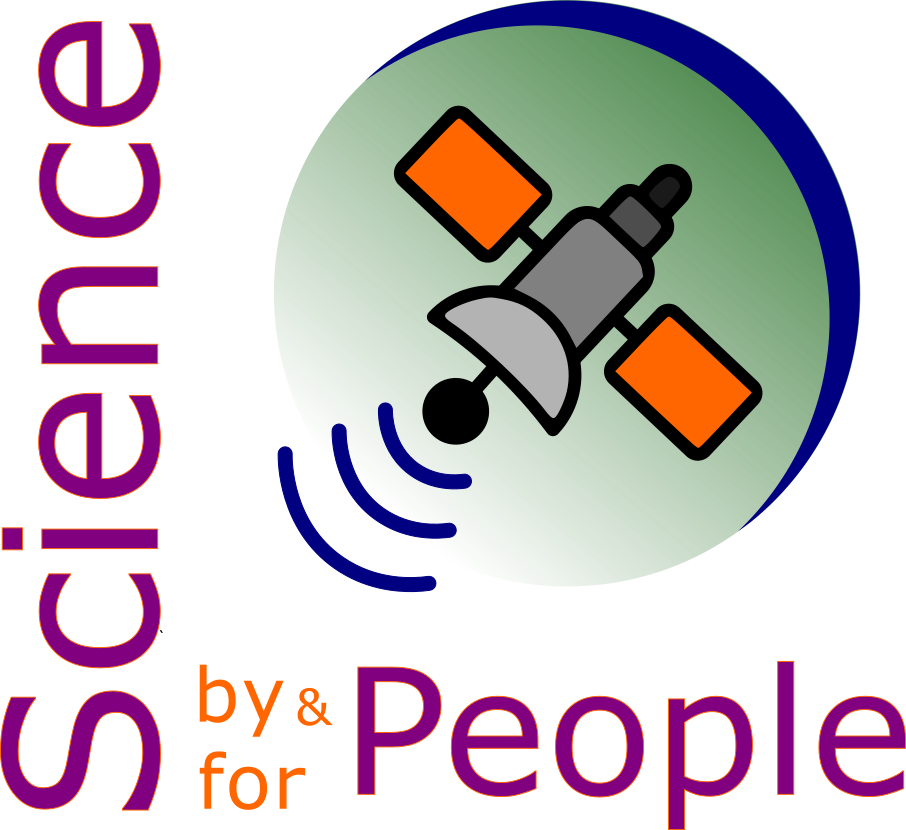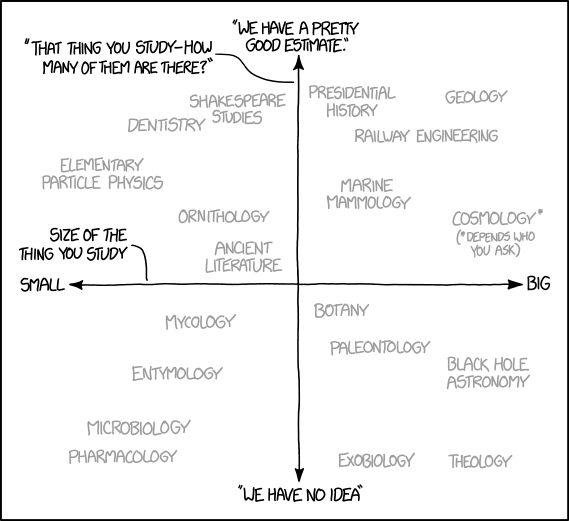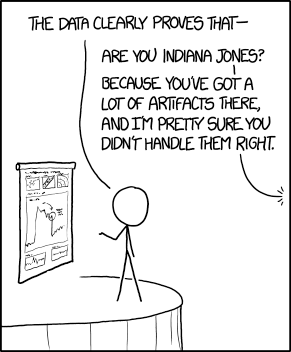Scientific Publication#
‣ Edito
Quick introduction
Plan
Introduction#
Science
Natural science is a branch of science concerned with the description, prediction, and understanding of natural phenomena. Those phenomena are divided into branches or fields like Physics, Astronomy, Chemistry, Biology and sub-fields (Organic Chemistry, Inorganic Chemistry, Astrochemistry, Quantum Chemistry …) that sometimes overlap between different branches. Scientific research rely on a systemic way of gathering and analysing data (empirical evidence) resulting from observation, experimentation and computation, aimed at increasing the global pool of humanity knowledge. Irrespective of their fields, scientists must employ the scientific method.
- you will have to communicate your research
Communication
There is two main channels that scientists use to share their work
History#
Review: [Nwagwu and Onyancha, 2015]
Note
Use this to subsection the history
1665 - 1940
From scholars to academics
Ressource: To Check
Scientific publication begin it’s journey in 1665 with the Philosophical Transactions of the Royal Society with contributions from Isaac Newton, Caroline Hershell, Benjamin Franklin, Charles Darwin… Publication of scientific work will remain in the hand of scientific society until the end of the second world war, a time when science publishers were notoriously inefficient and constantly broke, but science itself was about to enter a period of unprecedented growth resulting from government fundings.
Vocabulary
Scholars: A scholar is someone engaged in intellectual inquiry or intensive study. The term covers a wide range of career stages and types: advanced students, researchers employed at universities or hospitals or think tanks, people devoting their lives to religious study or writing, freelance or independent researchers. There are many awards, prizes, and fellowships whose title includes the word “scholar”; the recipient is generally supposed to be focused on intensive learning and/or research
Academics: An academic is a person employed to do teaching, research, or creative artistic work at an institution of higher education. The term is generally applied to someone who’s finished their postgraduate education and is pursuing a career in higher education. It isn’t used for undergraduates with part time university jobs; but it might sometimes be applied to advanced doctoral students.

Readings
[Fyfe, 2015]: Philosophical Transactions Finances
1950 -#
This is the time choosen by Robert Maxwell to enter the emerging business of scientific publication by creating the company Pergamon Press. As science was expanding, it become clear that it would need new journals to cover new areas of study, and while scientific societies argued about the boundaries of their fields, Pergamon just went to convince prominent academics that their particular fields required a new journal and install that person at the reins of it. They would then begin *selling subscriptions to university libraries which suddenly had a lot of government money to spend. From 40 journals in 1959, Pergamon was publishing 150 titles by 1965, scientific articles became the only way science was represented, and publishers were seen as a necessary partner in the advancement of science. Maxwell had transformed the business of publishing but science remained unchanged and scientist would published their work to whichever journal was the best fit for their research area. It is in the mid 70’s that publications became an inherent part of scientists career with the.
Scientific Journals#
Academic publishing is the subfield of publishing which distributes academic research and scholarship. Most academic work is published in academic journal articles, books or theses Scientific journals: periodical publication in which scholarship relating to a particular academic discipline is published Nowadays journals does not have a very good press as you can se from the articles listed on the right … Let’s try to understand why.
See also
Articles
Guardian Is the staggeringly profitable business of scientific publishing bad for science?
The Atlantic The Scientific Paper Is Obsolete, Here’s what’s next.
Works in progress The speed of science
Guardian The big idea: should we get rid of the scientific paper?
Huffpost Academic Journals: The Most Profitable Obsolete Technology in History
Podcast
» How it works#
‣ ‣ Missions #
Communicatig research
Editorial
Quality check
Recognition
Marketing
Disseminating
In Depth Explanation
The most obvious role of the journal is the selection of material. This is mainly subject based, Does this item fall within the remit of the journal and/or would it be of interest to our readers?.
This is the part played by the referees. A major part of the effort that sets the reputation of a journal is carried out by the referees.
The copy editing and general page design that make a journal look professional is carried out by copy editors and other non-academic professionals.
In terms of importance this ranks first from the point of view of many authors
Marketing of the journal to possible readers and other customers, e.g. libraries.
The delivery of the information (in the form of the physical item) to the purchaser or reader
Actors#
Now let’s have a look at the different actors of the publication sector
Publisher types |
# Articles |
1 |
2 |
3 |
|---|---|---|---|---|
Commercial |
||||
Government |
||||
Independant |
||||
Institute |
||||
Non-Profit |
||||
Society |
||||
Society or institution |
||||
University |
||||
University Press |
taken from [Morrison et al., 2022]
Note
To keep exctracting (don’t forget to keep up to date)
E-Publishing#
Arxiv#
PhysicsE-print Archive, founded by Paul Ginsparg [Ginsparg, 1994]
This "e-print archive" began as an experimental means of circumventing recognized inadequacies of research journals
Note
Insert JSOTR
Others e-publishing models#
[Swinnerton-Dyer, 1992]: Publishing model heavily influenced bythe paper model in operation and based around a centralised server
[Odlyzko, 1995]: outline model based on the interactive and less formal possibilities of net-based publishing
to ref: concerned mainly with the pre-formal communication stage between researchers
to ref: elaborates the earlier model to include a mechanism for peer-review.
[Ginsparg, 1997]: describes theoperation of a real working e-publishingmodel. In this case the question is notwhether it works (use of the PhysicsE-prints Archive is currently running ataround 70,000 connections per day6) butwhether the implicit model it embodies isapplicable to other areas of research.
It does (give example of bioarxiv, psyarxiv etc)
» Today
Society vs Commercial publishers#
ACS: American Chemical Society Link
RAS: Royal Astronomical Society
…
Note
May be can create a table to keep a log of the main ones
Are all of those society non-for-profit organizations? the ACS is non-profit but it is also condidered predatory for high journal price etc …
An example: Elsevier
now RELX
Owned journal:
1
2
Note
Publication pipeline
Preliminary screening by journal editor
Anonymous and private review by a very small number of individuals (2-5)
» What is right
Peer Review
Peer Review is necessary
Journal template ?
Very often publishing fees are justified by the employment of an army of editors that needs to be paid by the journal. Now sit down and think about it, you are actually doing the editorial job by using the journal latex template!
Good and bad:
You know what you are going to get but:
prevent creativity in sharing scientific content.
Reproducibility crisis in Science.
Lots of redundancy
Experiments are not described efficiently in scientific papers and hence are hardly reproducible, especially when dealing with metastable samples (like ASW)
Processing softwares not always shared
Data in databases is not efficiently described and hard to extract, reprocess (give example)
Overall, Scientific work is published in a Boring way, even though every piece of Science is interesting.
Oligarchy of scientific publishing#
Economics of scholarly publishing: Online article
more on economics from improve publication model: online article
How much does it cost#
[Walters, 2007]: speak about different business models
» What is wrong
Monetisation of knowledge
for the benefits of Journals
You need to pay to publish (not always, OK, but most of the time)
You need to pay to have access to publications.
Of course those “fees” are not paid by scientist themseleves, but rather by their institutions or funding bodies.
How much does it cost to publish an article: [Grossmann and Brembs, 2021]
to the detriment of Researchers
Loss of property rights over your work
Interstingly, while I am writing those lines along with wrapping up my PhD thesis, I am not paid by my institution - Pretty cruel system don’t you think ?
Increased poverty amoung PhD students
slavery …
Doesn’t really matt]er because we are passionate about what we do right ?
Well passion doesn’t bring food in the table.
A Monopoly#
What do they do with that money ?#
Surveillance#

Fig. 18 To modify#
Open Access
Yes, some journals offers Open Access, but very often it is a costly options as you need to pay Article Processing Charges (APC). For Nature they cost 9500 Euros !! (source: Here)
Journal Ranking#
Prestige, not quality
Tools#
Sherpa romeo: online resource that aggregates and analyses publisher open access policies
Also, for me, the problem is deeper.
Too many journal titles, enclose researcher into very narrow fields.
Astro thesaurus example, many subfields but is there a need for as many journal
Make comparaison:
List of all Asrto journals
The cost of Scientific publication
Promote competition vs collaboration
In the current atmosphere of highly competitive and uncertain research funding, publications are instrumental in determining how resources are distributed, who gets promoted, and in which directions research advances. This has cultivated a publish or perish mentalitywhere the focus is on maximizing the number of publications rather than on the validity and reproducibility of research findings as well as a decrease in the amount of information apportioned to each articles. ([Ghosh et al., 2012] copied from Intro)
Metrics
Impact Factor
Hierarchical stature of a journal is determined by the Impact factor metrics.
Have overtaken the review process as arbiters of quality and significance of research.
Astronomy papers ranked. - Sample size: 89
Are metrics a good indicator of paper quality#
Review: [Brembs et al., 2013]
H-index
Scientist are judged by their number of publication to climb the accademic ladder. This is measured using metrics.
Hence we all tend to publish quick and numerous papers, rather than well and low number
Puts scientist away from their main mission, understanding the bigger picture
The scatter problem#
Peer Review
Yes, I include the Peer Review process in this section as there is many flaws associated with it when performed in the context of commercial publications. [Ghosh et al., 2012] identified five of them:
Reviewers are expected to have comprehensive expertise
Reviewers do not have
Pressure to publish#
Poor reproducability#
Crisis ?#
Ok but journal put things in place, but is it effective
Reproducability vs replicability#
Alternatives#
Altmetrics#
Note
To explore
Actors of Scientific Publishing#
Clarivate#
Own:
Web of Science
Endnote
Journal Citation Report (Responsible for Impact Factor of many publications) - cf 2022 report
Revenus : 1,254 billion USD
Can we do better ?#
I am not the first one that have been asking this question
Below is a selection of a few articles from this special issue
Is the terrain favorable ?
Are researcher agreeing that a new method is necessary ?
How ?#
Note
a sneak look at the open source software development workflow
Learning from open source software projects to improve scientific review [Ghosh et al., 2012]
Describe:
Proposed system#
Describe:
Describe:
Open Research#
Alternatives#
Publishing Cooperatives#
[Raym, 2006]:
Open Journals#
Note
Ask Ross about volcanology publication (free)
Law Aspects#
[Manley, 2019]:
To Add#
Wrong#
Existing Formats Are Not Tailored for Knowledge Transfer
The recent development of new media and communicative possibilities using information technology, and the need to communicate and comprehend increasing amounts of additional information such as numerical and multimedia data, make the traditional forms inadequate. Continued reliance on paper documents and their electronic shadows make it very difficult or impossible to incorporate massive amounts of data, moving images or software; there is simply no natural way to associate such ancillary information ‘into’ the traditional publication. Additionally, any software-based text mining or information extraction procedures require that paper-based information first be converted into machine-tractable form and made freely available for such mining.
The Ever-Increasing Problem of Information Overload
Scholars have experienced information overload for more than a century [VICKERY, 1999] and the problem is just getting worse. Online access provides much better knowledge discovery and aggregation tools, but these tools struggle with the fragmentation of research communication caused by the rapid proliferation of increasingly specialized and overlapping journals, some with decreasing quality of reviewing.
Verifying Claims and Re-using Results
Even in the rare cases where the data are part of the research communication, these are typically relegated to the status of supplementary material, whose format [Murray-Rust, 2008] and preservation (find citation) are inadequate. At present it is difficult for a scholar easily and sustainably to record the data on which the work is based in a form that others can absorb and use, and to maintain links to the associated textual publication.
Best solution is to be in charge during the whole precess!
Note
Give example of astronomical (telescope) data
Other Problems#
Papermills#
Solution#
The Deconstructed Journeal#
Note
Looks interesting, to read
More#
Scientific revolution#
Note
Interesting but bulky (to read though)
Alternatives#
Review: [Herman et al., 2020]: Propose that journal transition can be splitted into 3 categories:
Enhanced models of the traditional scholarly journal
Innovative models of the traditional scholarly journal
Alternative modes of knowledge dissemination
Important Peoples#
Scihub
JSTOR#
Contraction of journal storage
Solution to the increasing number of academic journals in existence.
Preprints#
Experimental: [Chiarelli et al., 2019]
Definition#
Components
reproduced from [Chiarelli et al., 2019]
Keep checking to implement citations
The type of output that a preprint is meant to be
part of the scientific literature
A preprint is a complete scientific manuscript
Litterature
The position of a preprint in the knowledge production process
prior to formal publication
A ‘preprint’ is typically a version of a research paper that is shared on an online platform prior to, or during, a formal peer review process.
Litterature
Preprints as different versions of an output at different stages of the outputs’ lifecycle
before peer review
Preprints are made available “before, or in parallel to, submitting them to journals for traditional peer review.”
Litterature
The availability of preprints
preprints are openly available online
A preprint “can be viewed without charge on the Web.
Litterature
The individual(s) responsible for posting preprints
normally the author
A preprint “is uploaded by the authors to a public server.
Litterature
The usefulness of preprints to readers
preprints are considered valuable
“A preprint is a research output that has not completed a typical publication pipeline but is of value to the community and deserving of being easily discovered and accessed.
Litterature
Beyond#
Commenting#
[Marra, 2018]: check the commenting options from Arxiv
Electronic publishing#
Other Kinds of Scientific publication#
Note
To check for examples
Overlay Journals#
Replacement#
Digital publishing#
Business Model#
For me#
To include (alternatives)
Interesting Stuffs:
Blog:
Books
More
» Alternatives ?
Note
Quick paragraph to explain the need and the revolutionary movement in the US
Science for the people link
That is how I was planning to call my project but already taken
Include: openscholarlyinfrastructure
Internet#
Note
To insert: number of internet user worldwilde: Statistics
Other forms of scientific publication#
Blog#
Comments
Notes
Page
Author: Vincent Deguin;
Status:
🔎
Reviewed: ❌
Updated: 28/05/2023
Help






